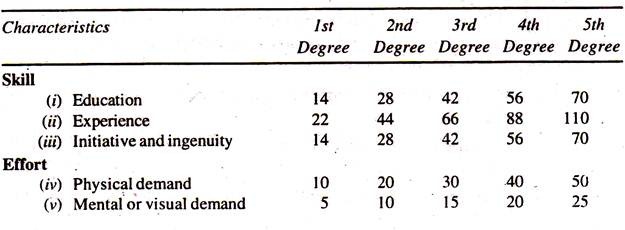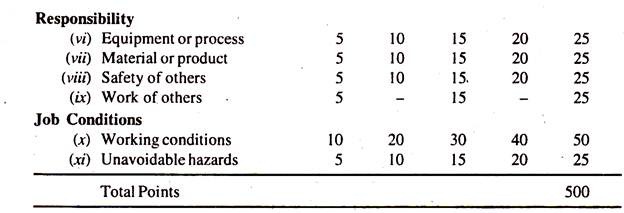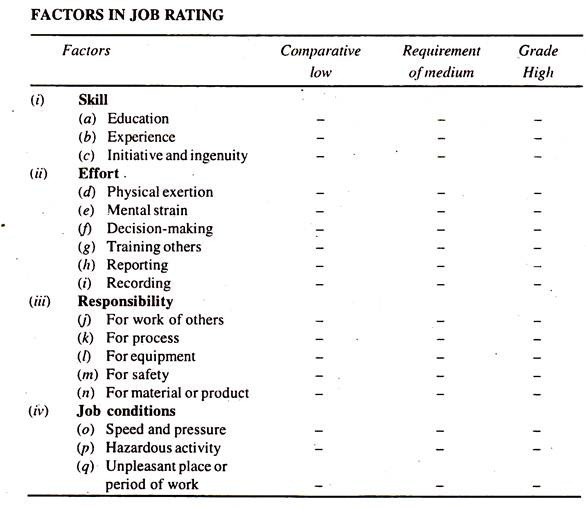Here is a compilation of essays on ‘Job Evaluation’ for class 11 and 12. Find paragraphs, long and short essays on ‘Job Evaluation’ especially written for school and college students.
Essay on Job Evaluation
Essay Contents:
- Essay on the Meaning of Job Evaluation
- Essay on the Principles of Job Evaluation
- Essay on the Purposes of Job Evaluation
- Essay on the Scope of Job Evaluation
- Essay on the Methods of Job Evaluation
- Essay on the Limitations and Criticisms of Job Evaluations
Essay # 1. Meaning of Job Evaluation:
It is a practice, which seeks to provide degree of objectivity in measuring the comparative value of jobs in an organisation and among similar organisations. It is essentially a job rating process, not the rating of employees.
ADVERTISEMENTS:
According to Kimball and Kimball, “Job evaluation represents an effort to determine the relative value of every job in a plant and to determine what the fair basic wage for such a job should be.”
Essay # 2. Principles of Job Evaluation:
As suggested by A.L. Kress, there are seven principles of job evaluation which are explained as follows:
i. Rate the Job and not the Man:
ADVERTISEMENTS:
The job requirements are definite and fixed. The man on the job may be paid according to the job requirements. A job rating plan should not grade the employees. The man on the job may be paid more or less than the job itself is worth, in relation to other jobs, Each element should, hence, be rated on the basis of what the job itself requires.
ii. Explainable Elements:
The elements should be as few in number as will cover the necessary requisites for every job.
iii. Uniformity of Understanding:
ADVERTISEMENTS:
The elements should be defined well.
iv. Foremen and Employees should know the Job Rating Plan:
It will give clear explanation and illustration of the plan.
v. Co-Operation from Employees:
ADVERTISEMENTS:
They will co-operate well, they are not required to discuss the rating.
vi. Discussion of Money Values be Avoided:
While dealing with foremen and employees have talks over point values and degrees of each element. Discussion on money values will lead to quarrels.
vii. Rates Ranges for Given Labour Grades:
ADVERTISEMENTS:
It would not be proper to adopt an occupational wage for each total of point values.
Essay # 3. Purposes of Job Evaluation:
The main objective of the evaluation is to establish the relative requirements of the jobs for the purpose of properly rewarding workers for the work performed.
Its other objectives are:
ADVERTISEMENTS:
i. Eliminating Inequalities:
The biggest single factor to job dissatisfaction is inequality of base rate for comparable work.
The actual rate paid changes due to length of service and merit rating of the incumbents. Thus, inequality of rate can be eliminated if the findings of the study are tested and applied.
ii. Solving Wage Controversies:
ADVERTISEMENTS:
It resolves wage controversies involving comparative rates.
iii. Eliminating Personal Prejudices:
It parts the rate structure on an objective basis. Here, job is rated and not the employee so it avoids favouritism. The employee’s rating is done by the process of merit rating that balances the job and the employee.
iv. Facility of Comparison and Survey:
It provides the information needed for community wage surveys and comparisons.
v. Establishing the Definite Plan of Salary Administration:
ADVERTISEMENTS:
Establishment of rates for different jobs, it guides as for a job. It also gives the lines of promotion.
vi. Proper Emphasis on Job Factors:
Job values are established by job factors. When these factors are applied to incumbent, they constitute the jobs specifications.
Essay # 4. Scope of Job Evaluation:
Evaluation of clerical, technical, professional and supervisory jobs handled more or less on the principles that are used in evaluating manual or factory jobs. The chief differences that are found to exist revolve round a different approach to the collection of information about the job and a different method of classification and control.
Production or factory employees are, usually studied from without, other employees, usually help in their own job rating either by filling out questionnaires or by answering questions about the job.
ADVERTISEMENTS:
Items of responsibility and confidential information must often be added to the clerical rating, while factors such as physical effort and hazards of the job lose their meaning. Regardless of the job or position that is evaluated, the chief need is to identify those characteristics which are essential to success on the job, such as the outstanding need of a radio announcer is that he has a pleasing voice and be able to read script that is prepared for him. Some people with a middle class education can meet this requirement and other with a doctorate in English could not.
Most office positions are evaluated in the following requirements:
(i) Education in years of schooling.
(ii) Accuracy.
(iii) Memory.
(iv) Supervision required.
ADVERTISEMENTS:
(v) Special skill, like typing, shorthand.
(vi) Relation with others, especially the public.
While considering supervisory positions another set of requirements are evaluated.
These, mostly include:
(i) Technical knowledge.
(ii) Experience.
ADVERTISEMENTS:
(iii) Experience of judgement.
(iv) Planning.
(v) Conditions of work.
(vi) Number of employees.
(vii) Responsibility for equipment and product
To evaluate supervisory of executive positions following requirement are considered:
ADVERTISEMENTS:
(i) Planning.
(ii) Policy formation.
(iii) Methods.
(iv) Administration.
(v) Personnel relations.
(vi) Executive contracts.
(vii) Original thinking.
(viii)Analysis.
(ix) Influence upon profits.
Essay # 5. Methods of Job Evaluation:
There are three methods of job evaluation.
They are as follows:
1. The Ranking or Grading Method:
The job descriptions are arranged in rank and according to the value of work as judged by the analysis.
It consists of three stages:
(i) Making a thorough job analysis.
(ii) Expressing the findings of this analysis in a job description.
(iii) Ranking each job by arranging them in ascending order, starting with one with the minimum need and ending up with the one with maximum needs.
In ranking the job, care is taken of a number of factors like:
(a) Volume of work,
(b) Difficulty of work,
(c) Monotony of work,
(d) Responsibility involved,
(e) Supervision needed,
(f) Knowledge and experience needed, and
(g) Working conditions.
Jobs are ranked first by departments. A comparison of department ranking is advisable so as to even up discrepancies in work of similar character.
The Advantages of Ranking System:
These are as follows:
(i) It is very simple.
(ii) It needs less time than other systems.
The Disadvantages of Ranking System:
These are as follows:
(i) It does not tell how much one job differs from another, only that it is higher or lower.
(ii) Unless the same detail is followed in the other system the analysis cannot possibly be so familiar with the job as they should and hence the ranking is likely to be inaccurate.
(iii) In the absence of details, analysis compromise plays an undue part and wages for the job are likely to influence the ranking.
This method is best suitable for small concerns.
2. The Factor Comparison or Weight-in-Money Method:
It is also called Benge Plan. It was originated by Eugene in 1928. The method analyses jobs on the basis of following five factors.
(i) Mental Requirements:
This factor is measured on the basis of concentration of attention (tension), intensity and frequency of thought necessary.
(ii) Skill Requirements:
These depend on three considerations:
(a) Length of training needed for an average employee to reach acceptable proficiency;
(b) The variety and complexity of the operations or activities of the job, and
(c) The dexterity and manual skill needed to perform the job satisfactorily.
(iii) Physical Requirements:
It measures fatigue, the laboriousness of the job and its posture requirements.
(iv) Responsibility:
It is estimated through the possible damage value. The job is responsible for the equipment damage possible, the tool and fixture damage and the responsibility for safety of other employees.
(v) Working Conditions:
The work location counts much. Dampness, wetness or very wetness of the location effects the working conditions. Noise involved, eye-strain, physical contact with oil, accident hazard and health due to dust or fume, all reflect the working conditions.
The jobs are ranked with each of the factors. Job and factors are compared. Money values are applied. Wage rate is fixed.
Advantages of Factor Comparison Method:
They are:
(i) Unlike jobs can be evaluated.
(ii) The system can be applied to combination of clerical, manual and supervisory positions.
Disadvantages of Factor Comparison Method:
They are:
(i) The method is complicated and installation is expensive.
(ii) They are not explainable to the workers easily.
(iii) It needs expert persons to its development.
(iv) It needs leadership by a competent and experienced practitioner.
3. Point System:
This system uses a manual. The manual gives elements or factors upon which each job is to be rated and provides scales and yardsticks by which each degree of each factor is to be valued. It describes many job elements and prescribes the weighing to be applied to each element.
It includes a scale for each element by means of which varying degrees are to be appraised. These degrees determine the number of points to be credited to the job. The total of such points establishes the point value of the job.
The four job factors common to practically all point methods of job rating are skill, effort, responsibility and job conditions. These may be, and usually are further sub-divided. The table shows the factors with the point values assigned to the various degrees.
Points Assigned to Characteristics and Degrees:
On the basis of analysis of such factors one may rank or grade the jobs. When the magnitude of an operation justified the paper work, this test of job requirements may be used to make written job specifications, i.e., a list of all functions needed of employee who fills each job.
There may also be a rating sheet for each job, listing the degree of skill, responsibility and effort, and the job conditions that are required, so that the enterprise may at all times have evidence that its policy in setting comparative wage rates is equitable.
Essay # 6. Limitations and Criticisms of Job Evaluations:
Job rating research experiments have shown again, and again that the factors mostly included in job evaluations are not independent. Mostly, they overlap. So, the weights used in many systems are subject to serious questions.
At the same time and perhaps for this reason, the reliability of job ratings is, often questionable. Reliability here means the consistency with which the same jobs are given similar ranks and ratings.
Criticism of Current Job Evaluation:
Viteles has criticised the current job evaluation system with following major points:
(i) Job evaluation gives a false sense of accuracy and there is a great deal of chaos yet to be eliminated by careful research.
(ii) Too many rating factors are used. These should never be more than five or ten.
(iii) Definitions of factors and degrees are not so accurately made as they could be in terms of action patterns and objective situations.
(iv) Too wide a range of factors is assumed and too many degrees are defined,
(v) Too great a controversy is raised over method and not enough attention paid to results.
(vi) ‘Mental-set’ of raters is allowed to influence results.
(vii) Since workers who feel that they are paid on the basis of merit will tend to be happier and more productive than those who have reason to argue the wage scale, more job evaluation is needed but it should be better job evaluation and might be made better if commonsense and a due regard for the scientific method were followed.


